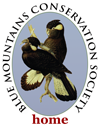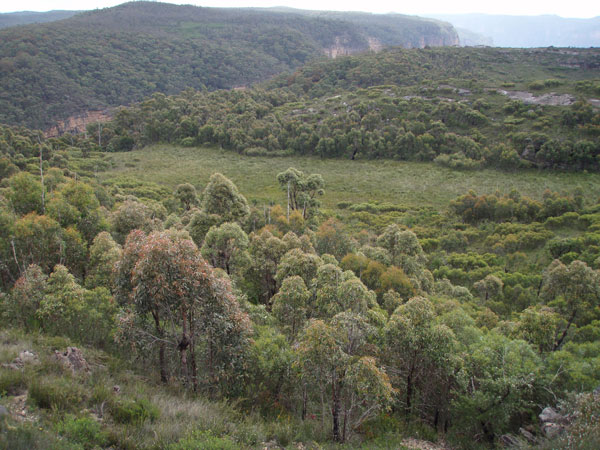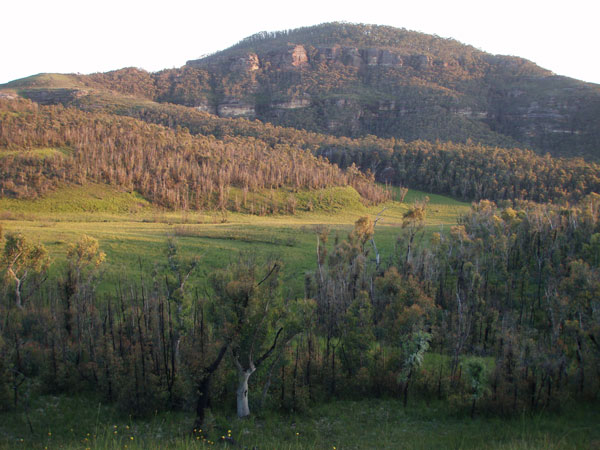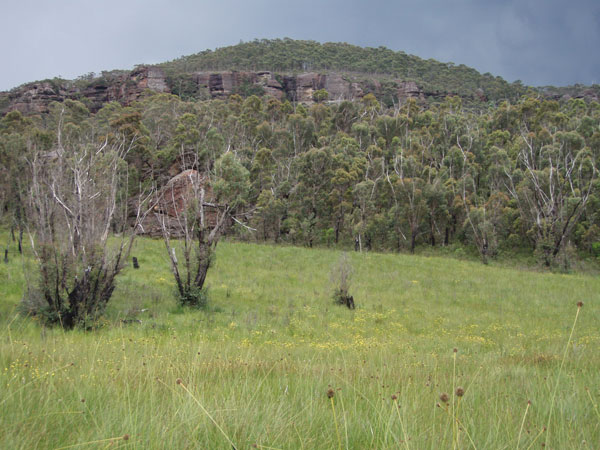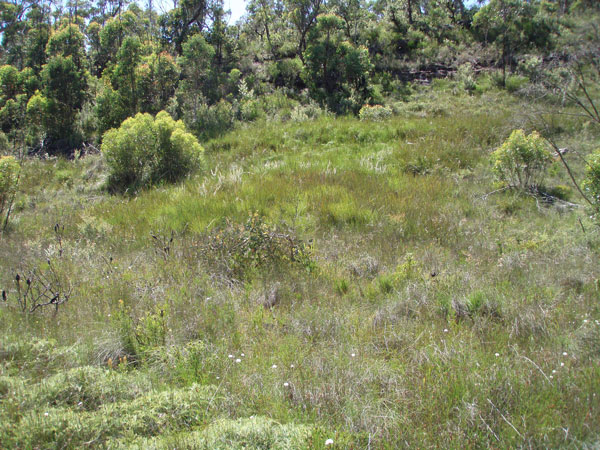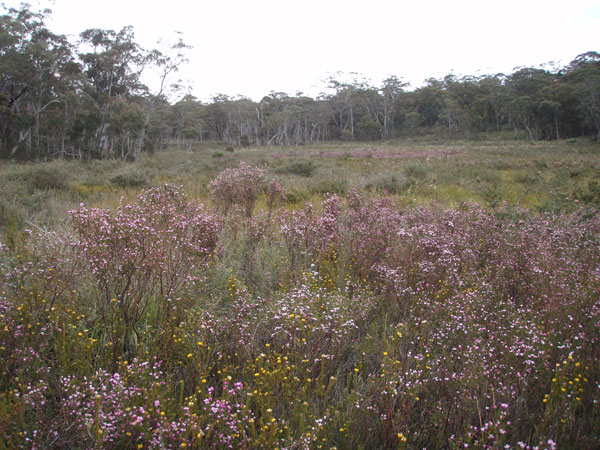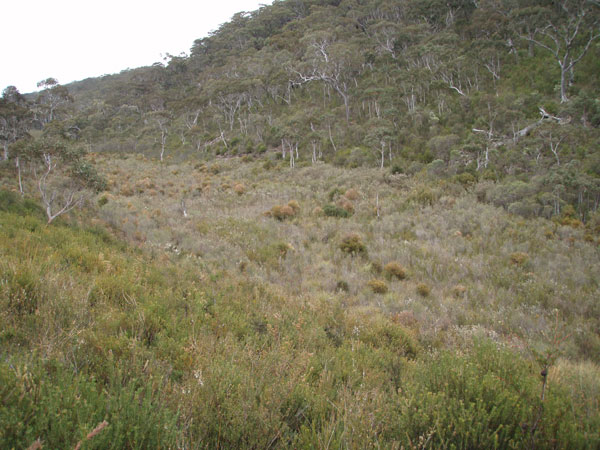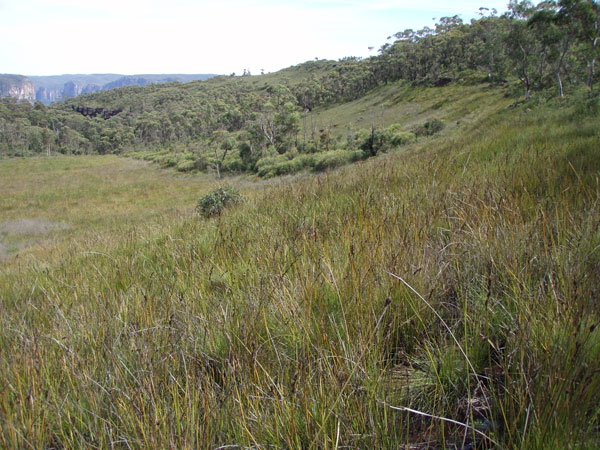 Blue Mountains Sedge Swamp, Mt Hay Range.
Blue Mountains Sedge Swamp, Mt Hay Range.
Photo by Ian Baird.
Introduction
This is the story of many small victories in a long and sustained effort to conserve Blue Mountains Swamps extending over 50 years.
It demonstrates the importance of scientists, planners, managers and ordinary people all contributing their skills and passions.
The impetus for the legal protections came from the community working through the Blue Mountains Conservation Society, who individually and collectively provided historic information, made submissions and resources, and never gave up.
Time Line
1959 Blue Mountains National Park was 'created' under a Trust and later 'gazetted' under the National Parks & Wildlife Act 1974 (NP&W Act). The Park provided some legal protection for those swamps located within its boundaries.
1974 PhD thesis (University of Sydney), by W N Holland 'Origin and development of hanging valleys in the Blue Mountains, NSW'; which showed the significance of the geomorphology on formation and maintenance of the hanging swamps.
The Blue Mountains Water Skink (Eulamprus leuraensis) was listed in a schedule of the NP&W Act, sometime between 1974 and 1995 (details to be confirmed).
1980-88 field work by W N Holland, D H Benson & R McRae on spatial and temporal variation in a perched headwater valley (Figures 1 & 2) in the Blue Mountains subsequently published in the Proceedings of the Linnean Society of NSW 113 (4) 1992.
1988 Ecologists, D. A. Keith & D. H. Benson described and mapped 'Blue Mountains Sedge Swamps' (Figures 1 - 5) and other upland swamps in 'The natural vegetation of the Katoomba 1:100 000 map sheet' (Cunninghamia 2(1), 107-143). This was followed by 'The natural vegetation of the Wallerawang 1:100 000 map sheet' (Benson & Keith 1990. Cunninghamia 2(2), 305-335), which included more comprehensive mapping of the Newnes Plateau Shrub Swamps (Figure 6).
1991 Blue Mountains Local Environment Plan 1991 (LEP 91) was gazetted, which included in its schedule of 'environmentally sensitive vegetation communities' two forms of swamps: (a) Closed Sedgelands (Hanging Swamps, Sedge Swamps) (Figures 2 - 5) and (b) Closed Heath, Open Heath (Hanging Swamps, Shrub Swamps) (Figure 7).
1995 NSW Threatened Species Conservation Act 1995 (TSC Act) gazetted, creating opportunities to list swamp communities and individual species.
1996 Blue Mountain Water Skink listed as endangered under the TSC Act. Species from schedules of the NP&W Act were transferred to new Act.
1996 – 2003 Blue Mountains Conservation Society (BMCS) attempted to use the TSC Act to protect swamps as habitat of a listed threatened species. This was attempted in 3 different cases (developments), each of which was unsuccessful, which highlighted the need for swamps to be listed in their own right.
- 1996-99: Development Approvals at 236 & 240 Connaught St, Blackheath. Approval was granted allowing for the construction of an access road through a swamp (which occurred in 2000).
- July 2000: Development Approval granted at 68 Fifth Avenue, Katoomba. Consent conditions prescribed limitations to clearing of vegetation. Blue Mountains City Council (BMCC) refused to enforce these.
- Dec 2001: approval of development that extended into a swamp at 60 First Ave, Nth Katoomba. No 8-part test carried out. BMCS commenced proceedings in the NSW Land and Environment Court to challenge the granting of the development consent. Legal advice in 2002 identified the inadequacy of the Threatened Species Recovery Plan for the Blue Mountain Water Skink to require the protection of Skink habitat through the DA process. [The plan contained no 'matters of substance…sections of the TSC Act are rendered useless if recovery plans do not contain provisions expressed in an objective and specific manner' (advice to BMCS)]
May 1997 Blue Mountains Sandstone Aquifer Status report published by NSW Department Land and Water Conservation recognizes the importance of 'hanging swamp' and 'hanging valley' vegetation communities.
December 1997 Judy and Peter Smith published Buffer Zones for the Protection of Sensitive Vegetation Units in the City of Blue Mountains. The study commissioned by BMCS and others established 60 m as the minimum buffer necessary to protect sensitive vegetation communities, such as swamps.
March 1998 Judy and Peter Smith published Sensitive Vegetation Units in the City of Blue Mountains. The study was commissioned by BMCS to identify and provide comprehensive descriptions of the sensitive vegetation units in the Blue Mountains LGA. These descriptions and species lists were subsequently used in the LEP 2005 and amendment 31 to LEP 91.
1998 Giant Dragonfly (Petalura gigantea) listed as endangered under TSC Act.
1999 – 2007 BMCS campaign over 8 years to gain legal protection for swamps, by obtaining a listing, which necessitated changes to the provisions of the TSC Act:
- February 1999: BMCS decided to investigate the feasibility of getting hanging swamps listed as a threatened community under the TSC Act.
- BMCS recognized that swamps would not satisfy the criteria as endangered and that there was no provision to list ecological communities as vulnerable, even though this existed for individual species. It was decided that that was worth trying and any refusal could be used as a lever for future change to the legislation.
- Haydn Washington was appointed as a consultant to prepare a nomination, drawing on the previous work by Tracey Austin and also from Peter & Judy Smith.
- It was decided to pursue the broader category of Blue Mountains Swamps, which would include both sedge and shrub swamps, on valley floors as well as valley sides. It was recognized that this may be more difficult to prove uniqueness, but would include the swamps most in need of protection.
- The observations of BMCS members were included in the nomination report, with 29 locations listed of swamps completely destroyed or degraded. NPWS provided maps for the nomination and Blue Mountains City Council staff provided supporting information.
- October 1999: The nomination was submitted to the NSW Scientific Committee.
- In July 2000 the NSW Scientific Committee advised that there was currently no provision in the NSW Act for the recognition of vulnerable ecological communities (VECs) and suggested that we pursue the new Commonwealth legislation, which had such a provision – The Environment Protection and Biodiversity Conservation Act 1999 (EPBC Act).
- The Society decided to follow two courses of action: firstly to nominate the swamps under the new EPBC Act, and secondly to start a campaign to change the NSW Act to make provision for vulnerable ecological communities.
- In July 2000 the Society met with Bob Debus asking for changes to the NSW Act to make provision for vulnerable ecological communities. As both the Minister for the Environment and the local member, Bob gave his support to protecting the swamps by NSW legislation.
- October 2000: BMCS gained the support of the NSW Nature Conservation Council (NCC) State Conference and NCC subsequently made representation to the NSW Government to add a VEC category to the TSC Act.
- October 2000: BMCS lodged a submission to nominate Blue Mountains Swamps for listing as a VEC under the Commonwealth EPBC Act.
- During 2001: community concern about the damage being wreaked on swamps heightened with particular concern about the damage to swamps in Lawson by trail bikes.
- 2001 – 2002: submissions and approaches to the NSW Department of Land and Water Conservation, the Minister and local state member, to develop and later to release the 'The NSW State Groundwater Dependent Ecosystem Policy', which was finally released in April 2002.
- Mid 2002: BMCS members met with Bob Debus to discuss these proposed amendments to the TSC Act. Bob made a personal undertaking to nominate Blue Mountains Swamps once the new 'vulnerable' category for ecological communities was established.
- October 200: an amendment to the TSC Act was passed, creating a new category of 'vulnerable ecological community', but with no mechanisms to deal with nominations.
- 2002 - 2007: Further correspondence continued between the Society and Bob Debus asking for a mechanism to implement changes to the TSC Act, and to implement his promise to list Blue Mountain Swamps. Also correspondence with Federal Minister for the Environment, re. a response to the Commonwealth nomination.
- May 2002: BMCS publicized the 'public exhibition' by Environment Australia on the proposal to list Blue Mountains Swamps under the EPBC Act, and assisted with inquiries on the criteria to be addressed. 26 submissions were known to have been submitted by the local community, as well as a very thorough submission from Blue Mountains City Council.
- February 2003: BMCS organized site visits for a delegation of officers from Environment Australia who were undertaking an assessment of the nomination under the EPBC Act.
April 2005 Blue Mountains Swamps were listed under the EPBC Act 1999, as one component of the more broadly defined 'Temperate Highland Peat Swamps on Sandstone', which gained listing as an endangered ecological community (EEC). For the purposes of this listing, Blue Mountains Swamps also included Newnes Plateau Shrub Swamps.
April 2005 BMCS published the booklet, Groundwater, by Brian Marshall, to promote public information and provide reference materials to agencies.
2005 Blue Mountains Local Environment Plan 2005 (LEP 2005) was gazetted, which not only included Blue Mountains Swamps in its schedule of 'significant vegetation communities' but also zoned all mapped swamps as Environmental Protection with a 10 m buffer included. [The Smith and Smith 1997 study commissioned by BMCS established 60 m as the minimum buffer necessary to protect significant vegetation communities. This was incorporated into the Planning Framework for the LEP (Environmental Management Plan 2002)]
2005 TSC Act lists Newnes Plateau Shrub Swamps as a separate endangered ecological community.
2006 Campaign against Spring Water in local community. Participation in Winter Magic Parade as Giant Dragonflies.
2006 Blue Mountains City Council's Swampcare and Swampwatch programs commenced with funding from the NSW Environmental Trust and BMCC's Environmental Levy. Swampcare facilitates volunteer involvement in restoration work in swamps and raising community awareness about Blue Mountains Swamps and their threatened species.
2006-2012 The 'Save our Swamps' project delivered a swamp restoration program on both public and private lands, as well as a community engagement program and a school education program across both the Lithgow and Blue Mountains LGAs. Workshops were held to increase the local community's awareness of swamps and to develop skills to engage in restoration works (particularly focused around the use of soft engineering techniques to rehydrate swamp systems).
September 2007 Blue Mountains Swamps were listed under the TSC Act as a VEC, the first listing in this category.
September 2007 Sydney Morning Herald article covered the community driven campaign, which resulted in the listing under the TSC Act.
2010-2012 Review of description of EPBC Act 'Temperate Highland Peat Swamps on Sandstone' endangered ecological community initiated by Commonwealth, following input by various experts.
2012 Revised draft description for THPSS provided to experts for comment, with a proposal to broaden the description to include peat swamps down to 20 m altitude, limit its extent to the Sydney Basin bioregion, and rename the endangered ecological community, 'Peaty Swamps on Sandstone of the Sydney Basin'. Revised description does not affect the Blue Mountains Swamps.
November 2012 Publication of a scientific paper on the groundwater dependence of NPSS and associated threatened plant and animal species highlighted the threats to those ecosystems, particularly from longwall coal mining (Benson D. & Baird I.R.C. Cunninghamia (2012) 12(4): 267-307)
In Summary
After 8 years, the Society’s 1999 objective has been achieved; which was to have Blue Mountains Swamps listed under the NSW legislation (2007). Along the way we achieved 3 other objectives:
◊ To gain recognition under the Commonwealth EPBC Act (in 2005),◊ To change the NSW TSC Act to make provision for vulnerable ecological communities (2002), and
◊ To increase the level of community awareness and support for swamps.
Figure 1.
Valley floor swamp of closed sedgeland and heath in perched headwater valley (centre), Mt Hay Range, Blue Mountains National Park, with Grose Valley rear right.
Photo by Ian Baird.
(click image to enlarge)
Figure 2.
Blue Mountains Sedge Swamp (Keith & Benson 1988) in perched headwater valley (Grose Valley rear), Mt Hay Range, Blue Mountains National Park; showing valley floor swamp (left) contiguous with hanging swamp on valley side (right). Note presence of horizontal upper swamp-woodland boundary associated with a relatively impermeable claystone layer (aquiclude/aquitard).
Photo by Ian Baird.
(click image to enlarge)
Figure 3.
Blue Mountains Sedge Swamp (Keith & Benson 1988) at head of Mt Hay Creek, Blue Mountains National Park (Mt Hay rear), showing large valley floor swamp complex with both contiguous and isolated patches of hanging swamps on valley sides.
Photo by Ian Baird.
(click image to enlarge)
Figure 4.
Blue Mountains Sedge Swamp (Keith & Benson 1988), head of Mt Hay Creek, Blue Mountains National Park, with Mt Hay (rear). Swamp sedgeland vegetation dominated by Buttongrass, Gymnoschoenus sphaerocephalus; yellow flowering Yellow-eyes, Xyris ustulata and Razor-sedge, Lepidosperma limicola.
Photo by Ian Baird.
(click image to enlarge)
Figure 5.
Small patch of hanging swamp of closed sedgeland associated with a seepage spring on a valley side, Bennett Gully, Blue Mountains National Park; adjacent to valley floor swamp (lower left) of sedgeland and heath.
Photo by Ian Baird.
(click image to enlarge)
Figure 6.
Newnes Plateau Shrub Swamp (Benson & Keith 1990) in low gradient headwater valley, upper Carne Creek, Newnes State Forest; with the threatened pink-flowering Deane's Boronia, Boronia deanei. These swamps comprise varying mosaics of heath and sedgeland.
Photo by Ian Baird.
(click image to enlarge)
Figure 7.
Dense valley floor shrub swamp dominated by closed heath with patches of closed sedgeland, Blue Mountains National Park, near Mount Wilson.
Photo by Ian Baird.
(click image to enlarge)
